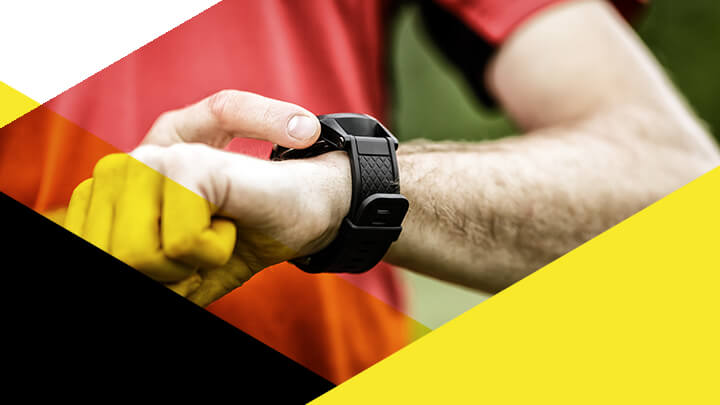Using Max HR percentage zones
How can you use maximum heart rate to identify the zone you should be training in?

Here at EOF, we use a percentage of your Maximum Heart rate (% Max HR) to identify the zone you should be working in and for what reason, it is not, however, the only way we manage training. We find it particularly important to help an advanced athlete become more specific in their training and enable them to maximise their full potential.
Working at perceived effort (NOT Heart Rate)
At the start of training, it is very likely that you do not understand how to determine your maximum heart rate and you might not use a monitoring system, such as a heart rate watch. This is not an issue and you can certainly use the same percentages for maximum heart rate as perceived exertion. Below is the perceived exertion at different percentages of max heart rate.
- 60-65% – Easy running – Feels easy and you are not out of breath at all, you can hold an easy conversation throughout. It may even feel too slow.
- 65-75% – Recovery – Short to mid-range duration and only for recovery. Feels very easy yet a little faster than easy running. You can still hold a conversation at this pace, but it’s slightly strained.
- 65-75% – LSD (long slow distance) – Easy pace as above, but for a longer period so you will start to feel tired toward the end.
- 75-82% – Efficiency – Starting to get out of breath quite a bit more and although you can hold a conversation, it is broken with the need to breathe a little harder and the need to concentrate on your effort.
- 82-88% – Very hard session – You need to concentrate on your effort. You can say a few words now and again but you will be very short of breath. A feeling that you are going to struggle to keep this pace for anything more than the duration set.
- 88-95% – Harder again – feels just short of sprinting. Heavy breathing and concentration is on perfect form and powering throughout, keeping your pace consistent.
- 95-100% – Maximum effort – drive your arms and legs as hard as you can.
Using Heart rate zones or perceived zones helps a person to better understand why they are training, what processes are occurring and at what level they are compromising themselves (LOAD). This is key to understanding why you train instead of just going for a run or cycle, for example.
This is what we use at EOF as a general rule. It’s worth noting that these do change very slightly depending on increased load with weight.
- 60-65% – Easy running – strengthens the heart muscle, stroke volume efficiency and mitochondria efficiency.
- 65-75% – Recovery – short to mid-range duration and only for recovery. Active recovery and removal of waste products.
- 65-75% – Long slow distance (LSD) – increased Mitochondria / energy efficiency.
- 75-82% – Efficiency – all functions and systems.
- 82-88% – Lactate threshold – Speed vs. Duration.
- 88-95% – Speed – high intensity sessions.
- 95-100% – VO2 Max – high intensity, power sessions.
- 100% – Power / Reaction time
There are a number of adaptations that occur when you train. These depend on whether you are sprinting for 10 seconds at 100% maximum or running at an easy pace for 35 minutes. It depends on the amount of stress you put on each body system (described in more detail above).
When you progress your fitness, you may wish to participate in an event or race, such as park run or a half marathon. During the event, the body will be pushed in all different areas at most levels and the body has to rely on all the systems, responding to the stresses, whilst deficit of oxygen and energy, in a state of high stress.
Even when you are not racing, the benefits of training all body systems and responses at a variety of levels will maximise efficiency, health and fitness overall. It will make you more capable and effective in all aspects of your life.
We separate all the fitness sessions into zones, as above, to ensure you are training specifically for what you want to achieve in that session. For example: if you want to train your energy system and build mitochondria then you train in the most effective range in stressing and adapting your mitochondria. If you are training to aide recovery, then you do exactly that in the recovery zone. Too many people just run or bike or train, bounding in and out of all of the zones, producing good but not optimal results, normally missing out on very specific training.
There is a time and place for merging sessions to replicate actual authentic racing and stimulus at all levels. We ensure you are ready and prepared physically to cope with those additional stresses, which can increase benefits in mental and physiological robustness and confidence.
Heart rate watches and straps
We cannot endorse these enough and if the budget allows – it is advised to purchase one that can provide you with heart rate capability. They all tend to be very accurate when used with a chest strap allowing you to capture analytics such as:
- Resting heart rate – can help determine your current fitness level, help with managing overtraining and if you are overtired and/or overstressed.
- HRV (Heart rate variability) – providing information to better inform you of the fluctuations in your heart rate which helps with understanding how your central nervous system is responding to training, sleep management, illness, diet and stress to name a few.
- Loading training status – can help you manage your loading, intensity minutes and load over a given period (usually 7 days). This will help you to not over or under train and slowly increase your fitness, health and performance correctly.
- Sleep pattern – Manage your sleep and its routines.
- Speeds, durations and distances – will help you keep an eye on your training, personal bests and where you are at now compared to where you were last year. It will aid how you specifically reflect on changes that can be made and understanding training methods that suit you more.
Some of these are no longer just heart rate monitors but a means to better understanding yourself at a physical and mental level and how it impacts your performance, emotions and stress levels. It is well worth the investment if you’re able.
Loading
At EOF we have the collective expertise and experience to offer the specific training support and education needed to progress your fitness safely while reducing the risk of injury.
There are many people, including athletes, trainers and coaches, who still struggle and wrestle with loading correctly. This includes the loading for recovery and tapering for pre-events too. It is vital that you load correctly to mitigate against injury, are able to recover while still training, in deficit and progress at the most efficient rate. All our programmes ensure this is done to allow you to reap the rewards of good training. It is not as simple as just doing your sessions each week and building on your LSD, Efficiency and tempo sessions. When considering threshold sessions (82-88% of Max HR) as an example, we break those sessions down into further categories of Tempo 1, 2 and 3; providing sessions with multiple reps of 4-15 min (T1), multiple sets with a max of 3 x 12-25 minutes (T2) and one rep of 20-60 minutes (T3). We ensure that over the entire period of the training plan (12 weeks for example) the increase of time between 82-88% is progressed.
Working across these three ranges allows you to increase your lactate threshold capacity specific to what you want. This will help you achieve all ranges of the most efficient zone for LT adaptation. Mixing up different durations and intensities ensures that it’s progressive throughout the whole process. This results in a more capable athlete and increased capacity to work at a high level for a longer duration and recovery from the hard sessions much later on in your programme.
Related Articles
If you've enjoyed this post why not try these related articles…



